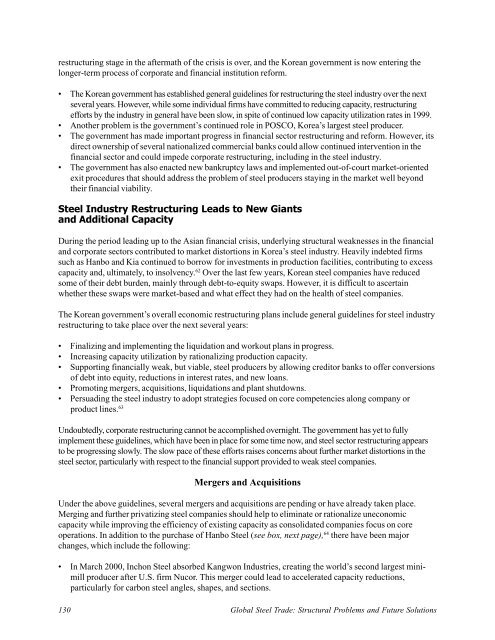Global Steel Trade; Structural Problems and Future Solutions
Global Steel Trade; Structural Problems and Future Solutions
Global Steel Trade; Structural Problems and Future Solutions
You also want an ePaper? Increase the reach of your titles
YUMPU automatically turns print PDFs into web optimized ePapers that Google loves.
estructuring stage in the aftermath of the crisis is over, <strong>and</strong> the Korean government is now entering the<br />
longer-term process of corporate <strong>and</strong> financial institution reform.<br />
• The Korean government has established general guidelines for restructuring the steel industry over the next<br />
several years. However, while some individual firms have committed to reducing capacity, restructuring<br />
efforts by the industry in general have been slow, in spite of continued low capacity utilization rates in 1999.<br />
• Another problem is the government’s continued role in POSCO, Korea’s largest steel producer.<br />
• The government has made important progress in financial sector restructuring <strong>and</strong> reform. However, its<br />
direct ownership of several nationalized commercial banks could allow continued intervention in the<br />
financial sector <strong>and</strong> could impede corporate restructuring, including in the steel industry.<br />
• The government has also enacted new bankruptcy laws <strong>and</strong> implemented out-of-court market-oriented<br />
exit procedures that should address the problem of steel producers staying in the market well beyond<br />
their financial viability.<br />
<strong>Steel</strong> Industry Restructuring Leads to New Giants<br />
<strong>and</strong> Additional Capacity<br />
During the period leading up to the Asian financial crisis, underlying structural weaknesses in the financial<br />
<strong>and</strong> corporate sectors contributed to market distortions in Korea’s steel industry. Heavily indebted firms<br />
such as Hanbo <strong>and</strong> Kia continued to borrow for investments in production facilities, contributing to excess<br />
capacity <strong>and</strong>, ultimately, to insolvency. 62 Over the last few years, Korean steel companies have reduced<br />
some of their debt burden, mainly through debt-to-equity swaps. However, it is difficult to ascertain<br />
whether these swaps were market-based <strong>and</strong> what effect they had on the health of steel companies.<br />
The Korean government’s overall economic restructuring plans include general guidelines for steel industry<br />
restructuring to take place over the next several years:<br />
• Finalizing <strong>and</strong> implementing the liquidation <strong>and</strong> workout plans in progress.<br />
• Increasing capacity utilization by rationalizing production capacity.<br />
• Supporting financially weak, but viable, steel producers by allowing creditor banks to offer conversions<br />
of debt into equity, reductions in interest rates, <strong>and</strong> new loans.<br />
• Promoting mergers, acquisitions, liquidations <strong>and</strong> plant shutdowns.<br />
• Persuading the steel industry to adopt strategies focused on core competencies along company or<br />
product lines. 63<br />
Undoubtedly, corporate restructuring cannot be accomplished overnight. The government has yet to fully<br />
implement these guidelines, which have been in place for some time now, <strong>and</strong> steel sector restructuring appears<br />
to be progressing slowly. The slow pace of these efforts raises concerns about further market distortions in the<br />
steel sector, particularly with respect to the financial support provided to weak steel companies.<br />
Mergers <strong>and</strong> Acquisitions<br />
Under the above guidelines, several mergers <strong>and</strong> acquisitions are pending or have already taken place.<br />
Merging <strong>and</strong> further privatizing steel companies should help to eliminate or rationalize uneconomic<br />
capacity while improving the efficiency of existing capacity as consolidated companies focus on core<br />
operations. In addition to the purchase of Hanbo <strong>Steel</strong> (see box, next page), 64 there have been major<br />
changes, which include the following:<br />
• In March 2000, Inchon <strong>Steel</strong> absorbed Kangwon Industries, creating the world’s second largest minimill<br />
producer after U.S. firm Nucor. This merger could lead to accelerated capacity reductions,<br />
particularly for carbon steel angles, shapes, <strong>and</strong> sections.<br />
130 <strong>Global</strong> <strong>Steel</strong> <strong>Trade</strong>: <strong>Structural</strong> <strong>Problems</strong> <strong>and</strong> <strong>Future</strong> <strong>Solutions</strong>
















